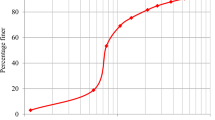Abstract
This paper presents the results of an experimental study on the fresh properties of the self-compacting lightweight concretes made with cold bond fly ash (FA) lightweight aggregates. Binary and ternary use of FA and silica fume (SF) blends have been investigated in the production of self-compacting cold bonded FA lightweight aggregate concretes (SCLWCs). A total of 9 SCLWC mixtures were proportioned having constant water-binder ratio of 0.35 and the total binder content of 550 kg/m3. The control mixture contained only Portland cement (PC) as the binder while the remaining mixtures incorporated binary and ternary blends of PC, FA, and SF. After mixing, the fresh properties of the SCLWC were tested for T 500 slump flow time, slump-flow diameter, V-funnel flow time and L-box height ratio. The fresh properties of SCLWCs with and without mineral admixtures were also evaluated by statistical technique, namely GLM-ANOVA. The results indicated that the combination use of FA and SF together decreased the slump flow time and V-funnel flow time. L-box height ratio, on the other hand, improved significantly.








Similar content being viewed by others
References
Zhanng MH, Gjorv OE (1991) Characteristics of lightweight aggregates for high strength concrete. ACI Mater J 88(2):150–158
Chang TP, Shieh MM (1996) Fracture properties of lightweight concrete. Cem Concr Res 26(2):181–188
Yang CC (1997) Approximate elastic moduli of lightweight concrete. Cem Concr Res 27(7):1021–1030
Cheeseman CR, Virdi GS (2005) Properties and microstructure of lightweight aggregate produced from sintered sewage sludge ash. Resour Conserv Recycl 45:18–30
Cheeseman CR, Makinde A, Bethanis S (2005) Properties of lightweight aggregate produced by rapid sintering of incinerator bottom ash. Resour Conserv Recycl 43:147–162
Mangialardi T (2001) Sintering of MSW fly ash for reuse as a concrete aggregate. J Hazard Mater B87:225–239
Kockal NU, Ozturan T (2010) Effects of lightweight fly ash aggregate properties on the behavior of lightweight concretes. J Hazard Mater 179:954–965
Kockal NU, Ozturan T (2011) Durability of lightweight concretes with lightweight fly ash aggregates. Constr Build Mater 25:1430–1438
Kockal NU, Ozturan T (2011) Characteristics of lightweight fly ash aggregates produced with different binders and heat treatments. Cem Concr Compos 33:61–67
Wang KS, Sun CJ, Yeh CC (2002) The thermotreatment of MSW incinerator fly ash for use as an aggregate: a study of the characteristics of size fractioning. Resour Conserv Recycl 35:177–190
Behera JP, Nayak BD, Ray HS, Sarangi B (2004) Lightweight concrete with sintered fly ash aggregate: a study on partial replacement to normal granite aggregate, IE (I) Journal 85:84–87
Chi JM, Huang R, Yang CC, Chang JJ (2003) Effect of aggregate properties on the strength and stiffness of lightweight concrete. Cem Concr Compos 25:197–205
Lo TY, Cui HZ (2004) Properties of green lightweight aggregate concrete, in: InternationalWokshopon Sustainable Development and Concrete Technology. Beijing, PRC, pp 113–118
Mor N (1992) Steel–concrete bond in high-strength lightweight concrete. ACI Mater J 89:76–82
Haque N, Al-Khaiyat H (1999) Strength and durability of lightweight concrete in hot marine exposure conditions. Mater Struct 32:533–538
Al-khaiyat H, Haque N (1999) Strength and durability of lightweight and normal weight concrete. J Mater Civ Eng 11(3):231–235
Kayali O, Haque MN, Zhu B (1999) Drying shrinkage of fiber-reinforced lightweight aggregate concrete containing fly ash. Cem Concr Res 29:1835–1840
Bignozzi MC, Sandrolini F (2006) Tyre rubber waste recycling in self-compacting concrete. Cem Concr Res 36:735–739
Zhu W, Bartos PVM (2003) Permeation properties of self-compacting concrete. Cem Concr Res 33:921–926
Phan TH, Chaouche M, Moranville M (2006) Influence of organic admixtures on rheological behavior of cement pastes. Cem Concr Res 36(10):1807–1813
Gesoglu M, Ozbay E (2007) Effects of mineral admixtures on fresh and hardened properties of self compacting concrete: binary, ternary and quaternary systems. Mater Struct 40:423–937
Bouzoubaa N, Lachemi M (2001) Self-compacting concrete incorporating high volumes of class F fly ash preliminary results. Cem Concr Res 31:413–420
ASTM C127-04 (2007) Standard test methods for density, relative density (specific gravity), and absorption of coarse aggregates. Annual book of ASTM standards
Harikrishnan and Ramamurthy k (2006) Influence of pelletization process on the properties of fly ash aggregates. Wastes manage 26(8):846–852
EFNARC (2005) Specification and guidelines for self-compacting concrete. Free pdf copy downloadable from http://www.efnarc.org
Babu KG, Rao GSN (1994) Early strength of fly ash concrete. Cem Concr Res 24:277–284
Güneyisi E (2010) Fresh properties of self-compacting rubberized concrete incorporated with fly ash. Mater Struct 43:1037–1048
Gesoglu M, Guneyisi E, Ozbay E (2009) Properties of self-compacting concretes made with binary, ternary, and quaternary cementitious blends of fly ash, blast furnace slag, and silica fume. Constr Build Mater 23:1847–1854
Güneyisi E, Gesoglu M, Özbay E (2011) Permeation properties of self-consolidating concretes with mineral admixtures. ACI Mater J 108:150–152
Neville AM (1996) Properties of concrete, 4th and final edn. Wiley, New York
McCarter WJ, Ezirim H, Emerson M (1992) Absorption of water and chloride into concrete. Mag Concr Res 44:31–37
Gesoglu M, Ozturan T, Guneyisi E (2006) Effects of cold-bonded fly ash aggregate properties on the shrinkage cracking of lightweight concrete. Cem Concr Compos 28:598–605
Sonebi M (2004) Medium strength self-compacting concrete containing fly ash: modeling using factorial experimental plans. Cem Concr Res 34:1199–1208
Scali MJ, Chin D, Berke NS (1987) Proceedings of ninth international conference on cement microscopy. Effect of micro silica and fly ash upon the microstructure and permeability of concrete. International Cement Microscopy Association, Duncanville
Carette GG, Malhotra VM (1983) Mechanical properties, durability, and drying shrinkage of Portland cement concrete incorporating silica fume. Cem Concr Aggreg 5:3–13
Sirinivasan CB, Narasimhan NL, Ilango SV (2003) Development of rapid-set high-strength cement using statistical experimental design. Cem Concr Res 33:1287–1292
Author information
Authors and Affiliations
Corresponding author
Rights and permissions
About this article
Cite this article
Güneyisi, E., Gesoğlu, M. & Booya, E. Fresh properties of self-compacting cold bonded fly ash lightweight aggregate concrete with different mineral admixtures. Mater Struct 45, 1849–1859 (2012). https://doi.org/10.1617/s11527-012-9874-6
Received:
Accepted:
Published:
Issue Date:
DOI: https://doi.org/10.1617/s11527-012-9874-6




